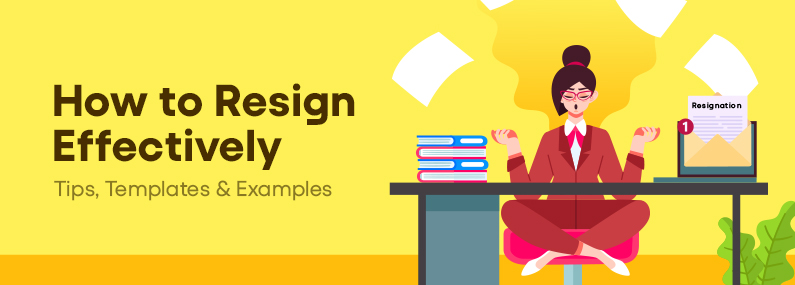Quitting a job is much more than just putting in your resignation notice. It’s the passing of an important professional milestone gracefully and in a thoughtful manner. Maybe it is a new opportunity you are moving into that promises to change your life for good, or maybe this is the opportunity when you finally decide to pursue further studies.
You could also quit for a much-needed career break. However, knowing how to resign from a company correctly is important because it makes a lasting impression. Resigning cordially speaks volumes about professionalism, respect for an employer, and commitment to maintaining good relations.
The resignation process is not merely a formality. It presents an opportunity to close one chapter of your career amicably while setting the stage for future prospects. Executed appropriately, it preserves your reputation, keeps doors open for potential networking, and ensures a smooth handover for your team. This comprehensive guide explores every facet of resigning effectively, from the initial decision to leave to crafting a polished resignation letter and serving your notice period professionally.
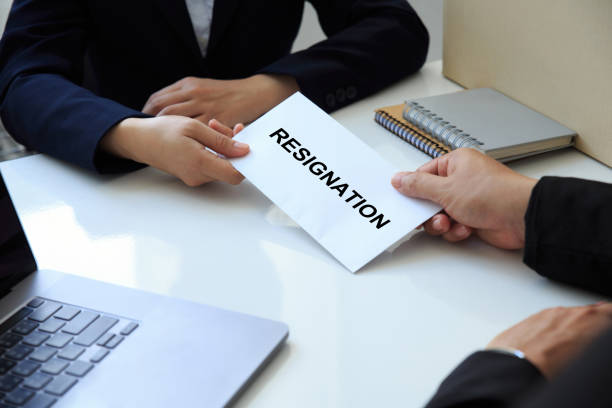
1. Preparation Before Resigning
Resignation demands careful planning to guarantee you leave on good terms. Hurrying through the process can harm relations and place your employer in a difficult position. Take these steps to prepare thoroughly.
1.1 Assess Your Decision Carefully
Before making your resignation official, evaluate why you’re considering leaving. Is it for career progression, achieving a healthier work-life balance, or escaping a toxic workplace? If some problems are addressable—like unmanageable workload or interpersonal conflicts—consult with your manager or human resources department immediately. At times, resolving internal issues can prevent you from experiencing unnecessary disruptions. However, if the choice aligns with your future objectives, you can tender a resignation confidently.
1.2 Review Your Employment Contract
The employment contract outlines pivotal specifics like notice periods, non-compete clauses, and other commitments. Violating these provisions could result in complications, such as forfeiting benefits or legal disputes. For example, non-compete agreements may restrict you from joining competitors for a specific timeframe. Being informed helps you navigate these conditions while strategising your departure prudently.
1.3 Plan Your Transition
Think about how you can ease the transition for your team and employer. Identify tasks that need completion and draft handover notes. You can also consider offering to train your replacement. A smooth handover reflects your professionalism and ensures you leave a positive impression.
1.4 Timing of Resignation
Choose a time that minimises disruptions. For example, resigning in the middle of a major project or during peak business periods might strain your team. Align your resignation with a time when your absence will have the least impact, showing consideration for the organisation’s needs.
2. Tips for Tendering Your Resignation Professionally
How you communicate your resignation matters greatly. A respectful approach leaves a lasting positive impression and keeps future opportunities available. So, here are some tips to ensure you are resigning on a professional note:
2.1 Schedule a Meeting
Calling for a private meeting with your supervisor face-to-face or virtually avoids surprising them during busy periods or team meetings. This dedicated time permits conveying your decision clearly without interruptions while maintaining respect.
2.2 Be Direct and Professional
Begin by directly and professionally expressing gratitude for the role and colleagues. Then, plainly state the intent to resign. For instance:
“Though I’ve thoroughly valued working here, I’ve decided to pursue a new opportunity better aligned with my long-term goals.”
Dodging or using vague language should be avoided. Being clear ensures your intentions are understood.
2.3 Provide Reasons (Optional)
You’re not obligated to explain your resignation, but if you choose to, keep it professional. For instance, focus on career development, new challenges, or personal growth. Avoid speaking negatively about the organisation or colleagues, as it may burn bridges.
2.4 Offer to Help with the Transition
Volunteering to assist during the transition demonstrates goodwill. This could include wrapping up key tasks or training your successor. Expressing your willingness to help reassures your employer that you value the team’s success.
3. Writing a Resignation Letter
A letter of resignation is more than just a formality. It is your opportunity to leave positive and long-lasting impressions on your employer. By writing a well-considered and professional resignation letter, you can ensure that the exit remains smooth and that goodwill is sustained for potential references or future collaborations. Let’s break down everything you need to know about writing the perfect resignation letter with care and consideration.
3.1 Purpose of a Resignation Letter
A resignation letter serves several important purposes:
- It officially notifies your employer of your decision to leave.
- This document also acts as a written record for HR and legal purposes, documenting your notice period and last working day.
- This letter provides a chance to express gratitude to your employer for the opportunities and experiences during your tenure.
- The resignation letter offers reassurance that you’ll help make the transition seamless.
Writing a well-structured letter ensures your resignation is handled professionally and strengthens your reputation.
People Also Read: Here’s How to Write a Formal Letter of Resignation
3.2 Key Elements to Include
Each part of a resignation letter plays a specific role. Let’s explore these elements in detail:
- Date of Submission
The letter should begin with the date it was drafted. This establishes a clear timeline for the notice period. Place the date at the top left corner or directly after your contact information.
Example: November 26, 2025
- Recipient
Address it to your immediate supervisor or human resources specialist. If your organisation has specific protocols, follow them. Use their name and title for a personalised effect.
Example:
Dear [Manager’s Name],
- Statement of Resignation:
Clearly state your intention to resign, leaving no ambiguity. Mention the role you’re resigning from.
Example:
I am writing to formally resign from my position as [Job Title] at [Company Name].
- Effective Date:
Specify your last working day based on the notice period required by your employment contract. This gives your employer a clear timeline to plan for your replacement or transition.
Example:
My final day of work will be [specific date].
- Expression of Gratitude
Use this section to thank your employer and team for the opportunities and experiences you’ve had. Be genuine and specific to leave a positive impression.
For example:
I am very thankful for the opportunities and guidance I have had here at [Company Name]. I will miss working with such an incredibly talented group of professionals. It’s been a personal and professional growth experience.
Also Read: How to Impress in an Interview
- Transition Assistance Offer
This includes volunteering to train your replacement or to help complete those “important” projects. This is yet another way to ensure that you leave work with the same commitment you started with.
Example:
I am fully committed to a smooth handover. During my remaining time, I am more than willing to train my replacement or assist further in preparing detailed handover notes.
- Closing Statement:
End with a polite and positive statement reiterating your appreciation and professionalism. Before signing your name, use terms such as “Sincerely,” “Best regards,” or “with appreciation.”
Example:
Thank you again for the opportunity to work with [Company Name]. I look forward to keeping in contact and best wishes to the company.
Best regards,
[Your Name]
3.3 Tone and Style
A resignation letter must be professional but warm at the same time. Here are some key tips to get the tone right:
- Keep It Brief: Don’t overexplain or include any irrelevant information. The ideal length is one page.
- Stay Positive: Don’t forget to highlight your positive experience and good aspects of your role, even though your experience wasn’t perfect.
- Avoid Negativity: Don’t criticise the company, management, or colleagues.
- Use Formal Language: Keep the tone professional and respectful.
4. Resignation Letter Template
Use this resignation template to draft your own:
| [Your Name] [Your Address] [Date] [Manager’s Name] [Company Name] Subject: Resignation Letter Dear [Manager’s Name], This is to formally inform you that I am resigning as [Your Job Title] for [Company Name], effective [Last Working Day]. It has been a great and fulfilling experience working at [Company Name]. It has been a pleasure working with you and my colleagues. I sincerely appreciate the opportunities for personal and professional development you have provided me. I will happily help anybody with the transition from my end by training my replacement or completing outstanding tasks. Thank you for the support, mentorship, and trust you have shown me throughout my time here. I wish you and everyone at [Company Name] all the best going forward. Sincerely, [Your Name] |
5. Examples of Resignation Letters
Now, we will walk you through some examples of resignation letters.
5.1 Example: Basic Resignation Letter
| Chloe Lim 10 Marina Boulevard Singapore 018983 26 November 2025 Samuel Tan Manager XYZ Technologies Pte Ltd Subject: Resignation Letter Dear Mr. Tan, I wish to inform you that I am resigning from my position as a Software Engineer at XYZ Technologies Pte Ltd, effective 12 December 2025. I am thankful for the opportunity to work with such a great team. I have learned so much and grown in so many ways. Besides, I am also grateful for all the help and guidance from you and all my colleagues here. I am committed to making a seamless transition and will be available after the fact to help complete any remaining transition activities. Thank you once again, and I wish XYZ Technologies Pte Ltd all the best for the future. Sincerely, Chloe Lim |
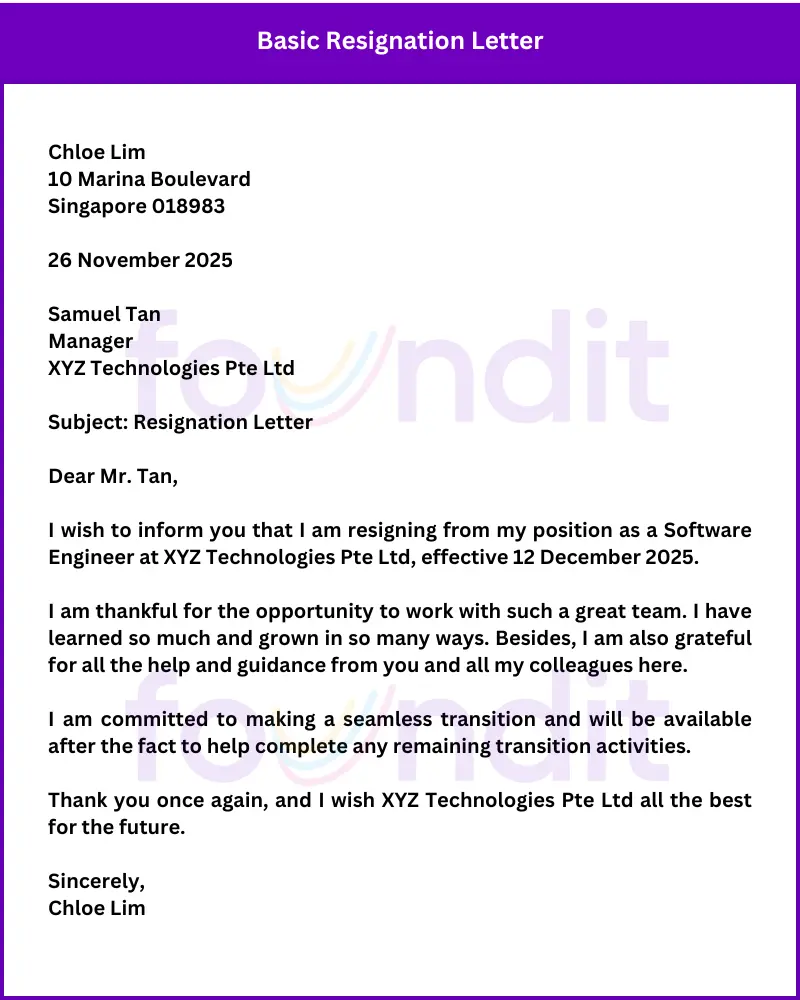
5.2 Example: Resignation for Career Advancement
| Ryan Tan 22 Holland Avenue Singapore 278966 26 November 2025 Rebecca Ong Director Bright Futures Consulting Subject: Resignation Letter Dear Ms. Ong, After careful consideration, I have decided to resign from the position of Business Analyst at Bright Futures Consulting, effective 12 December 2025. This is because an opportunity has come up for another organisation, and the role aligns with my long-term career aspirations. I appreciate the invaluable experiences and mentorship I have received here. The exposure and skills I have learned from Bright Futures Consulting equip me for this next great step. I commit myself to ensuring the transition is as smooth as possible and would not hesitate to help train a replacement or complete any pending tasks. Thank you once again for the opportunity to grow at Bright Futures Consulting. Wishing the team continued success. Best regards, Ryan Tan |
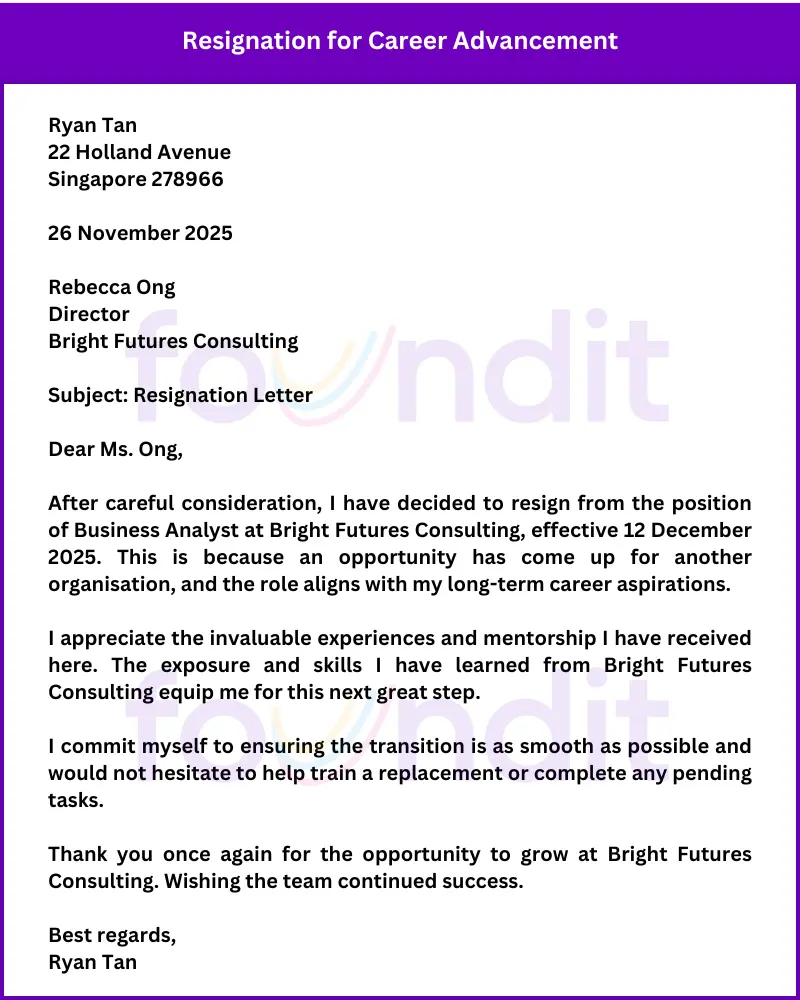
5.3 Example: Resignation Due to Personal Reasons
| Grace Ng 56 East Coast Road Singapore 428778 26 November 2025 Henry Koh Head of Operations Unity Logistics Pte Ltd Subject: Resignation Letter Dear Mr. Koh, I hereby submit my resignation from the position of Operations Executive at Unity Logistics Pte Ltd, effective 12 December 2025. This is due to some personal circumstances that require my complete attention. I am thoroughly grateful for the opportunities I have enjoyed here and the support from you and the team. Being part of Unity Logistics has been a very enriching experience. I will forever hold it in my memory and lessons. I will do everything possible to help during this transition time. If there is anything that I can do to help, please don’t hesitate to let me know. Thanks for all your understanding and support. Good luck to the company and the team. Sincerely, Grace Ng |
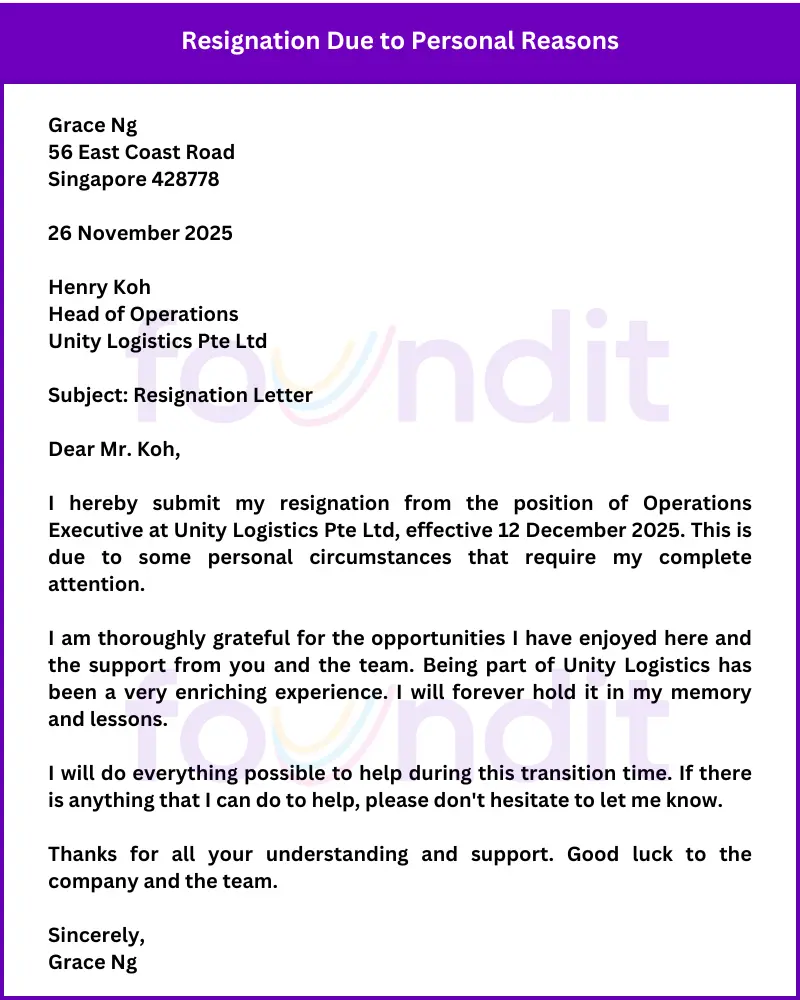
5.4 Example: Immediate Resignation Letter
| David Lee 89 Bukit Timah Road Singapore 229835 26 November 2025 Sophia Wong Manager Infinite Design Studio Pte Ltd Subject: Immediate Resignation Letter Dear Ms. Wong, I am writing to formally resign as a Graphic Designer from Infinite Design Studio Pte Ltd, effective immediately. Unfortunately, owing to circumstances that have arisen, I cannot give the company the standard notice period. I apologise for any inconvenience this may cause and will do my best to provide whatever assistance is available remotely or complete whatever documentation to make a more effective handover. I am grateful to have had the opportunity to work at Infinite Design Studio. I will always cherish the experience that ensued and also the support from my co-workers. Thank you for your understanding. I hope to stay in contact and wish you and the team all the best. Sincerely, David Lee |
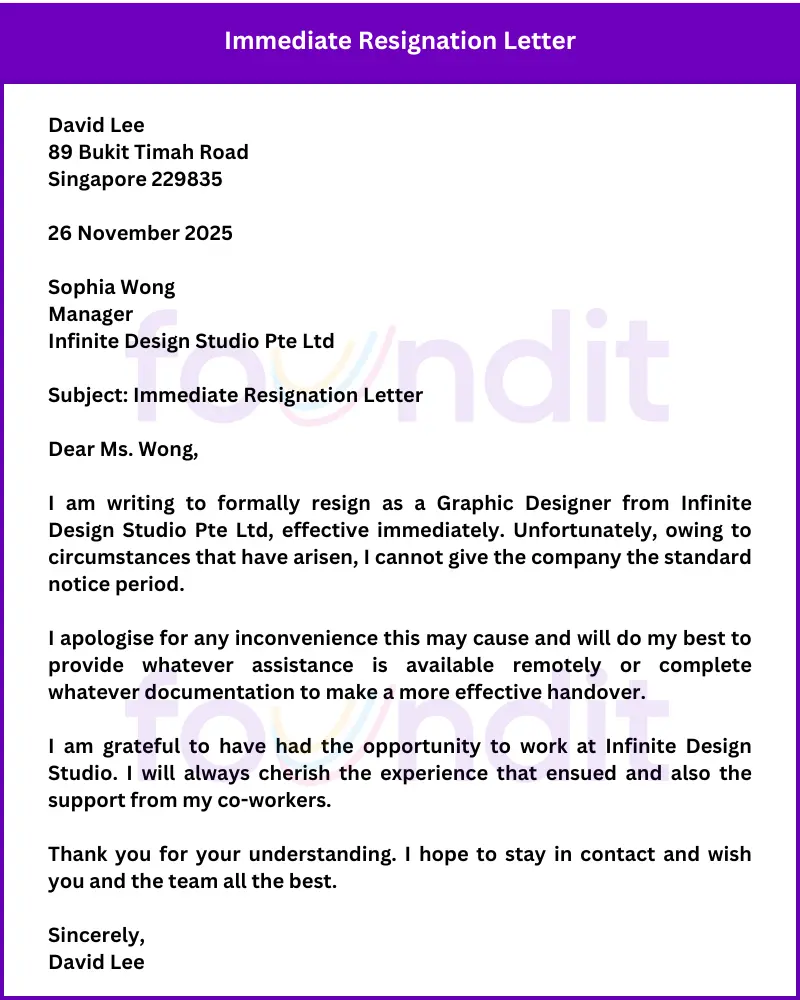
6. Final Steps After Resigning
The period after resigning is just as crucial as the act itself. It’s your last chance to leave a strong impression and tie up loose ends professionally.
6.1 Prepare for an Exit Interview
Exit interviews are an opportunity for you to provide constructive feedback. Focus on sharing insights about the workplace without being overly critical. This feedback can help the organisation improve and shows your commitment to professionalism.
6.2 Maintain Professionalism
Your notice period is an extension of your tenure. Continue fulfilling your responsibilities diligently and avoid slacking off. Remaining professional during this time demonstrates respect for your team and reinforces your work ethic.
6.3 Update Your Professional Network
Before leaving, connect with colleagues, mentors, and supervisors on networking platforms. A strong network can offer references, endorsements, or future opportunities. Send personalised messages to thank key individuals for their support and collaboration.
6.4 Handle Your Benefits and Finances
Clarify details about your final paycheck, unused vacation days, and benefits. Discuss what happens to your health insurance, retirement plans, or stock options after leaving. Being proactive about these matters ensures a smooth transition.
Conclusion
Resigning professionally is as important as your performance during your role. A well-planned resignation reflects your respect for the organisation, team, and yourself. Following these steps ensures a graceful exit while preserving valuable relationships and opportunities for future growth. Remember, every ending is a new beginning—how you leave one chapter sets the tone for the next.
FAQs on How to Resign Effectively
Q1: What is the ideal notice period for resignation?
A1: Typically, a two-week notice is standard, but your contract may require more. Always go through your employment agreement to determine the appropriate notice period.
Q2: Should I tell my colleagues about my resignation before informing my manager?
A2: No, inform your manager first. Sharing news with colleagues beforehand may create unnecessary confusion or disrupt team dynamics.
Q3: How can I handle counteroffers from my employer?
A3: Consider whether the counteroffer aligns with your goals. If you’ve already decided to leave, accepting a counteroffer might lead to future dissatisfaction.
Q4: Can I negotiate my notice period?
A4: Yes, discuss your circumstances with your manager. They may agree to a shorter notice if it doesn’t disrupt operations.
Q5: Is it okay to resign via email?
A5: Resigning via email is acceptable if in-person or video meetings are impossible. However, ensure the email is professional and concise.
Q6: How do I keep the resignation conversation positive?
A6: Focus on expressing gratitude and maintaining a respectful tone. Avoid negative remarks and emphasise your appreciation for the experiences gained.


